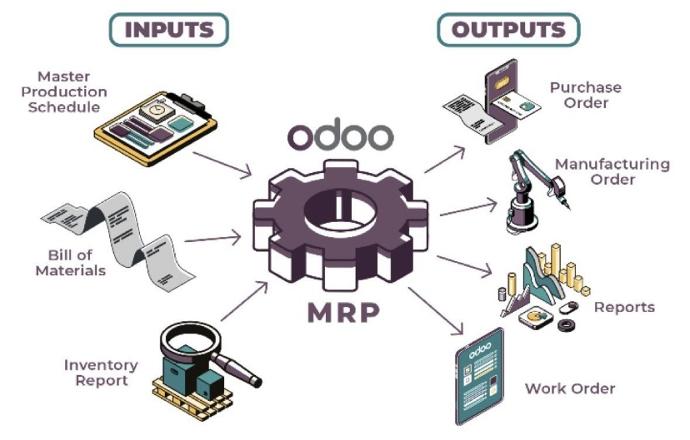The Evolution of ERP: From MRP to Modern-Day Odoo
History of ERP
In today's fast-paced business world, having efficient and integrated systems is crucial. From small startups to large enterprises, companies are increasingly relying on ERP (Enterprise Resource Planning) systems to streamline their operations and enhance decision-making. But where did it all begin? In this article, we'll trace back the origins of ERP, explore its evolution, and delve into the benefits of modern-day platforms like Odoo.

The Evolution of ERP: From MRP to Modern-Day Odoo
History of ERP
Introduction
In today's fast-paced business world, having efficient and integrated systems is crucial. From small startups to large enterprises, companies are increasingly relying on ERP (Enterprise Resource Planning) systems to streamline their operations and enhance decision-making. But where did it all begin? In this article, we'll trace back the origins of ERP, explore its evolution, and delve into the benefits of modern-day platforms like Odoo.
1. The Origins: Material Requirements Planning (MRP)
Before ERP became the powerhouse that it is today, there was MRP. MRP, or Material Requirements Planning, marked the inception of automated production planning in the 1960s and 1970s. Its primary function was simple yet revolutionary for its time: to ensure that the right materials were available for production and that products were available for delivery to customers.
Advantages of MRP:
• Inventory Management: MRP systems helped businesses keep track of their inventory levels, reducing the chances of stockouts or overstock situations.
• Production Scheduling: By analyzing sales forecasts and production costs, MRP systems could generate efficient production schedules, ensuring timely deliveries.
2. The Expansion: Manufacturing Resource Planning (MRP II)
As businesses grew and their needs evolved, so did MRP. By the 1980s, MRP made its transition to MRP II or Manufacturing Resource Planning. MRP II extended beyond the realms of inventory management and production scheduling. It integrated additional processes like financial management, capacity planning, and more, offering a more holistic view of the entire manufacturing process.
Key Features of MRP II:
• Financial Integration: MRP II systems integrated financial data, giving businesses insights into the financial implications of their production decisions.
• Capacity Planning: By considering machine and labor availability, MRP II systems could optimize production processes, ensuring that resources were utilized efficiently.
3. The Rise of Service Sector and Need for Integration
As the 20th century drew to a close, the business world witnessed a shift. The service sector began to overshadow physical product-based industries. Companies expanded globally, and their structures grew more complex. There arose a need for a system that could integrate various business functions, from HR to finance to customer service. Enter ERP.
4. Birth of Enterprise Resource Planning (ERP)
The dawn of ERP systems marked a new era in business management. No longer were companies restricted to manufacturing-focused systems. ERPs encompassed a broader range of business functions, from procurement to human resources to sales and marketing. By offering a unified platform, ERPs provided businesses with a bird's eye view of their operations, allowing for more informed decision-making.
Key Advantages of ERP:
• Centralized Data: With ERP systems, businesses could store all their data in one central location, promoting consistent data processing and reducing data redundancy.
• Enhanced Collaboration: Different departments could collaborate more seamlessly, having access to the same data in real-time.
• Scalability: ERPs were designed to grow with businesses. As a company expanded, additional modules could be incorporated without the need for major system overhauls.
5. The Modern Age: Embracing Odoo
Among the myriad of ERP solutions available today, Odoo stands out, and for good reason. Born in the age of open-source and cloud computing, Odoo presents a fresh, user-friendly approach to enterprise resource planning. Tailored for both SMEs and large enterprises, Odoo offers a suite of integrated apps that cover every business need.
Why Choose Odoo?
• Customizability: Odoo's modular structure allows businesses to choose only the apps they need, making it both cost-effective and tailored to specific requirements.
• User-Friendly Interface: Unlike traditional ERPs, which often come with a steep learning curve, Odoo is known for its intuitive user interface, making it easier for employees to adapt.
• Community and Support: Being open-source, Odoo boasts a robust community of developers and users. This ensures continuous improvements and a vast library of plugins and extensions.
6. A Glimpse Into the Future: Where is ERP Headed?
The world of ERP is ever-evolving. With advancements in AI, machine learning, and IoT, the next generation of ERP systems is set to be smarter and more interconnected than ever. Odoo, with its commitment to innovation, is well poised to lead this transformation, ensuring businesses are always a step ahead in this competitive landscape.
Conclusion
From the rudimentary days of MRP to the sophisticated platforms of today like Odoo, the journey of ERP systems mirrors the evolution of the business world. As we move forward, it's clear that integrated systems like ERPs will continue to play a pivotal role in shaping the future of business operations. For those looking to stay ahead of the curve, embracing modern solutions like Odoo is not just a choice, but a necessity.
Marmara ERP Group
Welcome to the Marmara ERP Group, where we share knowledge on Open Source Odoo ERP system, discuss best practices, and collaborate on innovative ideas to maximize the potential of our ERP implementations. Let's grow together!